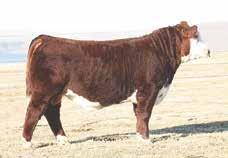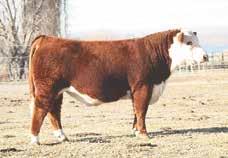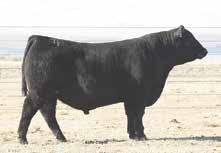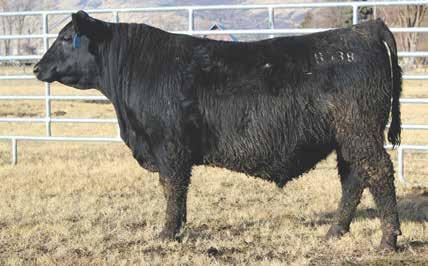
14 minute read
NATIONAL PERSPECTIVE
GRATITUDE AND OPTIMISM THE POSITIVE SIDE OF THE NEW ADMINISTRATION
by NCBA Chief Executive Officer Colin Woodall
At noon on January 20th, Joe Biden became the 46th President of the United States. Since Election Day, I have had almost daily calls from cattle producers asking about the new administration and its impact on our industry. My message from the get-go has been clear: it is going to be okay.
President Biden brings many things to the table we have not seen in quite some time. He is a former U.S. Senator we worked with, and he spent eight years as Vice President where we learned even more about him. He is a known commodity and is bringing familiar faces back to work for him. Tom Vilsack has been nominated to reprise his role as Secretary of Agriculture, a post he held for eight years under President Obama. We had our challenges with Secretary Vilsack on topics such as keeping the government out of dictating how we market cattle, but we also had significant wins like returning beef to the center of the plate in the 2015 Dietary Guidelines for Americans. We had a lot of experience with Secretary Vilsack and we know we can work with him.
Another familiar face is Katherine Tai, nominee for U.S. Trade Representative. Our team has worked with her on trade issues at the House Ways and Means Committee. Her fluency in Mandarin Chinese will make her very valuable, especially since one of President Biden’s challenges will be holding the Chinese accountable for their trade commitments on beef and other agricultural goods. Ms. Tai understands the complicated nature of the Chinese trade relationship and is prepared to work on our behalf. Knowing how important trade is to our industry, we need a U.S. Trade Representative who will expand global access for U.S. beef.
We began working very closely with President Biden’s transition team after the election to educate them on all our priorities, and the reception has been positive. In fact, we met with the President’s nominee for EPA Administrator, Michael Regan, and I was surprised and pleased with his commitment to learn more about the cattle industry and our issues. The President’s team continues to talk about climate change, and they have concentrated part of that discussion on agriculture. We must be at the table to defend the great work we have done in protecting the land. There is no doubt in my mind we will have plenty of challenges ahead of us, but we are prepared to defend our role in food security, nutrition, animal care and natural resource stewardship. However, we will also have opportunities in trade and 24 California Cattleman February 2021 in showcasing our role as part of the solution to environmental issues.
While we are anxiously looking at what the next four years may bring, it is important that we review the past four years under President Trump. The events in early January resulted in an unfortunate end to the Trump Administration, and feelings remain raw across the board. While the opinions of President Trump continue to run from hatred to admiration, I simply want to address our experience with him. Regardless of your opinion or position, I will argue that he has been one of the most cattle-friendly presidents we have had.
I met and interacted with President Trump many times during his administration, and I can tell you he is a very genuine and down-to-earth gentleman. Even though I did not always agree with the way he conducted business, we cannot argue with the number of wins we achieved under his leadership. Thanks to a simple steak lunch during golf with Chinese President Xi Jinping, we got beef back into China and our exports have grown since. We repealed and replaced EPA’s Waters of the United States (WOTUS) rule. We made significant improvements to the Endangered Species Act and National Environmental Policy Act (NEPA). The gray wolf was delisted. The list goes on and on because he appreciated what cattle producers do, and he appreciated the way NCBA takes care of business.
While we are starting off on the right foot with the Biden Administration, we know that every presidential administration, regardless of political party, delivers challenges. NCBA’s full-time presence in Washington, D.C., has us prepared to face the challenges and ultimately win. Our quest is to keep the government out of your business.
The next four years will be an adventure, but I am optimistic that NCBA will do what we have always done – build relationships, educate administration officials and fight for your right to raise cattle.
LOT 45
12:30 P.M. MST ~ AT THE RANCH, BRUNEAU, IDAHO
LOT 24 LOT 46
AHA 44122963

CED 5.8 BW 3.9 C CJC 4264 LAD 0137 ET WW YW 69 110 MM 31 Awesome look and pedigree in this prospect. REA 0.42 Dark red color with big red eyes. He is a MARB CHB 0.51 167 maternal brother to Belle Heir and with chart topping IMF and CHB values. Genomics say he should be an easier calving sire while still staying in the top 2% of the breed for growth at both weight periods.
LOT 96
AHA 44122903

CED 4.4 BW 2.6
C 2052 LONG RANGE 0074 ET WW YW 59 98 MM 32 This Long Range son blends together every- REA 0.39 thing cattlemen are searching for into one com- MARB CHB 0.25 123 plete package. He comes from one of our most popular donors 2052 and has so many of her qualities that made her a standout. Huge bodied with tons of shape and doability. He truly bridges the gap between good cattle that have calving ease, performance, maternal traits and carcass.
LOT 40

AHA 44122964

CED 1.7 BW 2.6
C 1311 LONG RANGE 0138 ET WW YW 57 95 MM 31 Here is a polled Long Range son out of Miles REA 0.65 McKee’s full sister 1311. If you are looking for MARB CHB 0.06 118 an all around sire with tremendous phenotype and look this is a great place to land. His mother is one of the best donors we have produced and her presence in pedigrees is a must. She is close of having one million dollars of progeny sales with numerous daughters being flushed.
LOT 94
AHA 44077440

CED 7.2 BW 2.4 C 1311 MR CANADA 9324 ET WW YW 61 90 MM 38 Mr. Canada son out of a full sister to Miles REA 0.79 McKee. Maternal brother to Double Your MARB CHB -0.01 104 Miles, Special Edition and numerous donors like 6018. Lots of calving ease with as much pigment and maternal excellence as you can build in one.
LOT 21
AHA 44122948

CED -0.6 BW 4.0
C 1311 4013 INNISFAIL 0121 ET WW YW 68 105 MM 30 This young herd sire will be found by many top REA 0.54 cattlemen this spring. He is a full brother to the MARB CHB 0.42 160 lot 11 female from the fall sale that so many were trying to own. Performance and weight with a 160 CHB in the top 1% of the breed but still has the maternal strength.
LOT 141
AHA 44077469

CED -0.6 BW 3.4 C BAR1 BAILEE VALOR 9354 WW YW 66 109 MM 22 Exciting young sire with as much look and REA 0.77 quality as you can find. He is bred for standout MARB CHB 0.14 154 phenotype but has a great EPD profile to go along with it. Huge growth numbers with excellent carcass traits place him in the top 2% for CHB.
LOT 158
AHA 44122894

CED 9.5 BW 0.3 C BELLE HEIR 0065 WW YW 60 88 MM 36 This young sire could prove to be very useful REA 0.53 when breeding replacement females this spring. MARB CHB 0.35 145 He is out of a first calf heifer that made it straight to the donor pen. Use this one for udder quality and calving ease but also his carcass values and look makes him a big time prospect.
AAA 19778381

BW 0.2 WW 70 YW 123 SC .83 CEM 12 CCC BANKROLL 0007 MILK $W 35 87 Big time herd sire prospect that is out of a first $F $G 94 57 calf heifer. He has been a standout in the group $B $C 151 277 because of his extra muscle and rib shape. Balanced EPD profile with enhanced REA and $W values. He has the phenotype of a western ranchers kind with a set of numbers that are hard to find a hole in.
AAA 19778409

BW 1.1 WW 91 YW 145 SC 0.59 CEM 8 CCC CASINO BOMBER 0043 MILK $W 13 81 This Bomber son has a great look with an explo- $F $G 92 52 sive growth curve that places him among the $B $C 144 249 breeds elite. He is in the top 1% WW and top 2% for YW. His mother has been a top producer posting WWR of 103 and YWR of 106.
~ OFFERING 250 BULLS & 45 FEMALES ~ Guy, Sherry and Katie Colyer, 208.845.2313 Horned Hereford | Polled Hereford | Angus Two-Year-Olds, Senior Yearlings and Yearlings Kyle, 208.250.3924 • GUY cell: 208.599.0340 email: guy@hereford.com • FAX: 208.845.2314 Sale broadcast live on ... February 2021 California Cattleman 25
UCANR RELEASES NEW PUBLICATION THAT SYNTHESIZES SCIENTIFIC KNOWLEDGE ON ANNUAL RANGELAND
Decades of research-based knowledge about the history, physical characteristics and vegetation in California annual grassland, oak-woodland and chaparral ecosystems has been consolidated in a new nine-part PDF document. The 200-page publication, The Ecology and Management of Annual Rangeland Series, is available for free download from the University of California Agriculture and Natural Resources (UCANR) catalog.
The series includes past and current practices for managing vegetation, grazing and livestock compiled by researchers at the University of California, U.S. Department of Agriculture and other agencies and universities.
UC Cooperative Extension rangeland specialist emeritus Mel George, the lead author, said the series has been under development for 10 years. Until his retirement in 2012, George hosted an annual rangeland shortcourse, in which rangeland managers gathered for three days in Davis for presentations, field visits and printed handouts. He collected the materials and created a searchable archive of 700 rangeland publications on the UC Rangeland website, and, with a team of co-authors, summarized the most important information for the new series.
“Information on rangelands doesn’t change very fast,” George said. “We have materials that are 20 years old that are still usable; even 100 years old, in a couple of cases.”
Part 1: Mediterranean climate. The locations and characteristics that define a Mediterranean climate.
Part 2: Ecological history. California has some of the most productive croplands in the world. Recently, increasing conflicts among urban development, intensive agriculture and protectionism have led to rigid distinctions among resource management objectives. Having a long-term perspective on the causes and interpretation of changes in the landscape can aid in resolving conflicting goals and objectives among stakeholders.
Part 3: Soils. Researchers and managers like to organize the world they live in so that they can explain their environment. This publication presents the soil taxonomy developed by soil scientists to classify soils and understand soil similarities and differences.
Part 4: History of range livestock production. Range livestock production developed as an enterprise with the colonization of California by the Spanish and their formation of ranches or ranchos, and it expanded rapidly during early statehood. The development of improved animal 26 California Cattleman February 2021 management and range management practices ensured that the industry would continue its dominance in California agriculture throughout the 20th century and into the 21st century.
Part 5: Range plant growth and development. The plants that dominate California’s annual grasslands and the understory of the oak woodlands have different life cycles from most of the world’s rangelands. This publication delves into morphological and physiological changes associated with annual and perennial life cycles, photosynthesis and carbohydrate storage and the effect of grazing on individual plants of California’s annualdominated rangelands in the Coast Range and the foothills of the Sierra Nevada.
Part 6: Vegetation change and ecosystem services. Vegetation types in the annual rangelands include annualdominated non-native grasslands, native-dominated grasslands, oak woodlands, chaparral and coastal scrub. The ecosystem services, or benefits, that humans obtain from each vegetation type change as the vegetation type changes. This section describes the dominant and common species in each vegetation type, the vegetation changes and change agents that are commonly recognized, and an approach to evaluating ecosystem services.
Part 7: Livestock production. Livestock production on California’s annual rangelands has adapted to the seasonality of rangeland forage dominated by annual grasses and forbs growing in a Mediterranean-type climate. This part gives an overview of seasonal forage sources, nutrient requirements of grazing animals, seasonal forage
...CONTINUED ON PAGE 28

quality, seasonal animal performance, supplemental feeding, water needs, livestock production systems and animal health issues.
Part 8: Grazing management. The response of vegetation, livestock and ecosystems to grazing is complex, and grazing managers are confronted with a variety of grazing strategies or systems that are sometimes hard to compare or evaluate. This part covers what are commonly known as the four components of grazing — intensity, season, frequency and duration — and their effects on annual rangelands and provides an overview of the adaptive management process of planning, implementation and learning that grazing managers can use to help them cope with complexity and knowledge.
Part 9: Vegetation management. An overview of the research and practices for brush and weed control, seeding and fertilization. Also covered are practices that reduce seasonal gaps in forage availability and quality and the economics of vegetation management.
The Ecology and Management of Annual Rangeland Series is found at https://anrcatalog.ucanr.edu/Details. aspx?itemNo=8540.

Specializing in Truck and Livestock Scales

Established in 1959, Scales NW offers a wide range of equipment, from precision lab balances to high capacity rail scales, as well as certified scale service and installation.
Contact Steve Orr for more information today! Email: steveorr@scalesnw.com Phone: (503) 510-3540
www.scalesnw.com • (800) 451-0187
AD_POWELL_LivestockTruckScale.indd 1 Scales NW is proud to serve: California Idaho Montana Nevada Oregon Utah Washington
1/11/2018 1:35:26 PM
CALF EQUIPMENT GATES AND PANELS CATTLE GUARDS & MORE!
SQUEEZE CHUTES HEAD GATES CATTLE WORKING SYSTEMS



Since 1938, Powder River has provided the highest quality and most durable products available for the livestock industry. Conlin Supply Co. carries the full line of Powder River’s squeeze chutes, working systems, classic gates and panels which are unsurpassed in quality, functionality and reliability, making them an overall great investment. Stop by either of our locations to see the full line of products...
576 Warnerville Rd., Oakdale, CA •(209) 847-8977 • M-F: 7:30 a.m.-5:30 p.m. • Sat: 8 a.m.-5 p.m. • Sun: 10 a.m.-4 p.m. 717 E. Childs Ave. • Merced, CA • (209) 725-1100 • M-F: 8 a.m.-5:30 p.m. • Sat: 8 a.m.-1 p.m. • WWW.CONLINSUPPLY.COM • California Cattleman February 2021
BUCHANAN ANGUS RANCH ANNUAL BULL SALE

A TRUE Performance Program
With Guest Consignors
Where performance doesn’t START at the feed Bunk
PICTURES WORTH A THOUSAND WORDS

NOON on SUNDAY February 28, 2021

Klamath County Fairgrounds Klamath Falls,OR

Broadcast live on: LiveAuctions.TV 816-392-9241
LOT: 13 “Algoma Golden Tahoe B338 Reg# 19860485 who is a calving-ease son of “Tehama Tahoe” out of a “S Whitlock” daughter
LOT: 14 “Algoma Golden Stateline B339” Reg# 19856914
He is a calving-ease son of “Tehama Tahoe” out of a “Basin Payweight 1682”daughter Selling sons of: Capitalist 316 BUBS Southern Charm AA31
Musgrave 316 Exclusive
Reisig Intrigue 4407
Tehama Tahoe B767 Jindra Acclaim
Basin Rainmaker 4404 Spring Cove Compound 12E
E&B Everett and others

NEW THIS YEAR
● ● Many Calving-Ease Bulls sell 1st year breeding season guarantee ● Free delivery for the first 500 miles ● We can feed the bulls until turnout
Selling Pen Lots of breeding age heifers
B A Angus Buchanan

Cattle Business our ONLY Business
Robert and Kathleen Buchanan and family 13490 Algoma RD Klamath Falls, OR 97601










